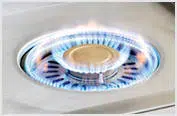Loading ...
Loading ...
Loading ...

15
RUST-BROWN MARKS:
When this type of staining occurs it is unlikely that rusting of the stainless steel itself causes the marks.
Similar marks can be found with both porcelain and plastic sinks. The rust marks are more likely to be
the result of small particles of “ordinary-steel” which have become attached to the surface; these have
subsequently rusted in the damp environment. The most common source of such particles is from “wire-
wool” scouring pads, but contamination may also occur from carbon steel utensils and old cast iron wa-
ter supply pipes.
These brown marks are only superficial stains, which will not harm the unit; they should be removable
using a soft damp cloth and a multi-purpose cream cleanser.
Occasionally, it may be necessary to resort to a proprietary stainless steel cleanser, to return the surface
of the unit to its original condition. To avoid re-occurrence of any “rust-staining” it is essential that the
source of the contamination be eliminated.
PITTING:
Another form of corrosion, which occasionally occurs in stainless steel, is pitting of the surface. The rea-
son for this corrosive attack can usually be attributed to certain household products, for example:
Bleaches:
Most common domestic bleaches & sterilizing solutions contain chlorine in the form of sodium hypochlo-
rite. If used in concentrated form, bleaches can attack the stainless steel, causing pitting of the surface.
They should always be used to the strengths prescribed by the manufacturer and should be thoroughly
rinsed off with clean water immediately after use. All cleaning agents containing hypochlorite are unsuit-
able for long term contact with stainless steel and, even when used in the highly diluted form, they can
give pitting under certain conditions.
Foodstuffs:
In general stainless steel is fully resistant to all foodstuffs in common use. Only in isolated cases, such
as when concentrated salt and vinegar mixtures are allowed to remain in contact with the steel for a long
period, can any surface marking result.
CARE & MAINTENANCE OF YOUR UNIT:
GRATE:
The easiest way to clean the round wire grate is immediately after cooking is completed and after turning
off the flame. Wear a barbeque mitt to protect your hand from the heat and steam. Dip a brass bristle
barbeque brush type in hot soapy water and scrub the hot unit grate. Dip the brush frequently in the bowl
of water. Steam, created as water contacts the hot grate, assists the cleaning process by softening any
food particles. If the grate is allowed to cool before cleaning, then cleaning will be harder.
STAINLESS STEEL:
The VERSAPOWER™ Cooking System is made from commercial quality type 304 non-rusting and non-
magnetic stainless steel, and the cleaning information shown on Page 14 should be followed.
DRIP TRAY:
The drip tray should be cleaned after every usage of the
unit. After allowing the unit to cool completely, remove
the drip tray by pulling it out from the unit
WARNING
DO NOT ALLOW EXCESS GREASE
OR LIQUIDS TO ACCUMULATE IN
THE DRIP TRAY AS THIS WILL CRE-
ATE A FIRE HAZARD.
Loading ...
Loading ...
Loading ...
